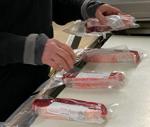Country of origin labeling has peppered ag news and consumer sites for many years.
The 2002 Farm Bill led the way for the labeling of agricultural products in retail markets. USDA rules were not completed until January 2009, and were revised in May 2013.
The major change in 2013 was significant. Meat processed from different countries on the same day in a particular plant could not be comingled. This meant all meat was sorted by country of origin and was no longer labeled with either/or. This rule change led to a two-year spike in prices for cattle producers. And while COOL led to higher prices for cattlemen, grocery store prices remained relatively stable.
When I reviewed USDA numbers of retail prices for all 2013 cuts of beef, the price was $5.29 per pound. The National Farmers Organization group I market my cattle through sold our heavy steers at $1.54 per pound at 675 pounds.
In 2014, when COOL was enacted, the retail price increased to $5.97 per pound. That significant price rise came in at 11%. That year, we sold our heavy steers for $1.94 per pound, or 25% higher.
In 2015, the retail price for beef hit $6.29 per pound and we sold heavy steers for $2.47 per pound.
Life seemed good for the feeder and rancher. We made a profit and planned ranch projects.
One thing I know about farmers and ranchers is that money does not stay in their pockets long. In agriculture, we are always updating equipment, corrals or buildings. When ag producers have money, they invest in their farms, which helps not only the rural economy, but also the national economy.
Changing Times
In December 2015, Congress passed a bill that removed COOL from pork and beef. So, what happened to retail beef prices? They went down to $5.96 per pound, or about the same level as the first year of COOL. What was the impact on cattle producers? Here on my farm, we sold our 675 pound steers for $1.40 per pound, which totaled a loss of over 40% of our income. But the retail price stayed just under $6 per pound.
My question is, if the retail counter price is stable, and it ranged between $5.91 and $6.04 per pound in 2017-2019, yet producer prices hovered around $1.50 per pound for heavy steers, who is making all the money? I know everyone along the food chain needs to make a profit, but why is such a small slice of the pie going back to producers?
My point: COOL led to better prices for the folks working with the animals. If you believe, like me, that we should know where our meat comes from and that producers should receive their fair share of the pie, then call your U.S. senators and representatives. Tell them to re-enact COOL for both pork and beef.
If the next generation is to return to the farm and raise their families in rural America, then we need to let our voices be heard. Remember, you know where your clothes are made, where your fruits and vegetables are grown and where your toaster is made, but our government asserts through policy that pork and beef are not important enough to be labeled.
Right now, USDA allows using the phrase “product of the USA” for pork and beef. But what does it really mean? It means beef and pork carcasses imported from any other country can be labeled as a “product of the USA” if those carcasses from other countries are cut into retail items here in the U.S. for sale in grocery stores.
This labeling practice is simple and completely deceptive. Millions of consumers visit their local retail meat counters and, seeing the “product of USA” designation, draw the honest, mistaken conclusion that the meat they are buying is USA raised and fed. That just doesn’t sit right with me. How about you?
The Link LonkApril 15, 2021 at 02:00PM
https://ift.tt/3wWY53Z
Opinion: Stay COOL | Beef & Cattle Farming News | lancasterfarming.com - Lancaster Farming
https://ift.tt/2RxTDX4
Beef



No comments:
Post a Comment